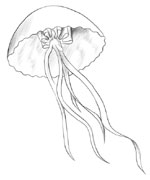How to Treat Jellyfish Stings
How to Treat Jellyfish Stings

mushroom shape and a
gel-like body.
Jellyfish are aptly named. Their gelatinous, cloudy bodies look like globs of jelly. But the ugly body is not what's dangerous. The dangerous parts are the cells that adhere to their dangling brownish tentacles; those cells contain a poisonous and vicious venom that causes a painful sting in humans.
Jellyfish “epidemics” are usually cyclical, occurring at specific times during the summer. One day, you are swimming in clear water, and the next day the water is cloudy with floating jellyfish, adrift in the waves. Avoiding jellyfish is the best solution, but sometimes a long tentacle can get you even if the jellyfish body is far away. Symptoms of a jellyfish sting can include:
| Immediate searing pain | Swelling at the site |
| A red rash | Nausea and vomiting |
| Cramps | Shock (in severe cases) |
| Breathing problems (in severe cases) |
Ouch!
It's always a good idea to have a physician check out fish bites, but not every bite is an emergency that requires immediate profession attention. If the person is suffering from shock, of course, help must be swift. Further, a sting on the face, especially near the eyes or the neck, can cause dangerous swelling, which should always receive quick medical attention. If you see signs of fever, swelling, or other atypical symptoms, get medical help. If there's nothing more than a painful sting, a topical antibacterial ointment and dressing might be all that's needed.
If someone gets stung by a jellyfish, follow these steps to provide first aid for the wound:
- Check vital signs. If the victim seems to be in shock or having trouble breathing, immediately begin first aid for these conditions (see How to Treat Wounds and Stop Bleeding) and call for medical help.
- Wrapping your hand in a towel or wearing a protective glove, wipe away any dangling tentacles from the wound site. (Be careful. You don't want the tentacles to touch your skin!)
- Remove any jewelry near the site (even from the hand/wrist if the upper arm is stung).
- Alcohol or ammonia will neutralize a jellyfish's poison. Simply wash the wound with either one. Alcohol can be used full strength. However, you should dilute the ammonia with fresh water (¼ part ammonia to 1 part fresh water). The chemical structure of salt water can dilute the ammonia's fighting power. If it's convenient, you can dilute a whole bottle of ammonia in two inches of bath water and have the victim sit in the bath for about an hour.
- Dry the wound site with sand, powder, or cornstarch. Try not to apply creams or lotions if the sting is not neutralized, because it might trap the poison in the skin.
- If there is swelling at the site, place a cold compress or an ice pack on the bite for twenty minutes every hour—or until help comes.
If the pain is very intense, try rinsing the bite site with some baking soda and water after you've followed your first aid steps. It can help decrease the pain until medical help arrives.
Even if the sting is mild and the victim feels fine soon after the episode, it's good to keep watch for up to three days later. Jellyfish stings can get infected days after the incident. The best prevention? Antibacterial ointment—once the stinging sensation is gone. Before then …ouch!